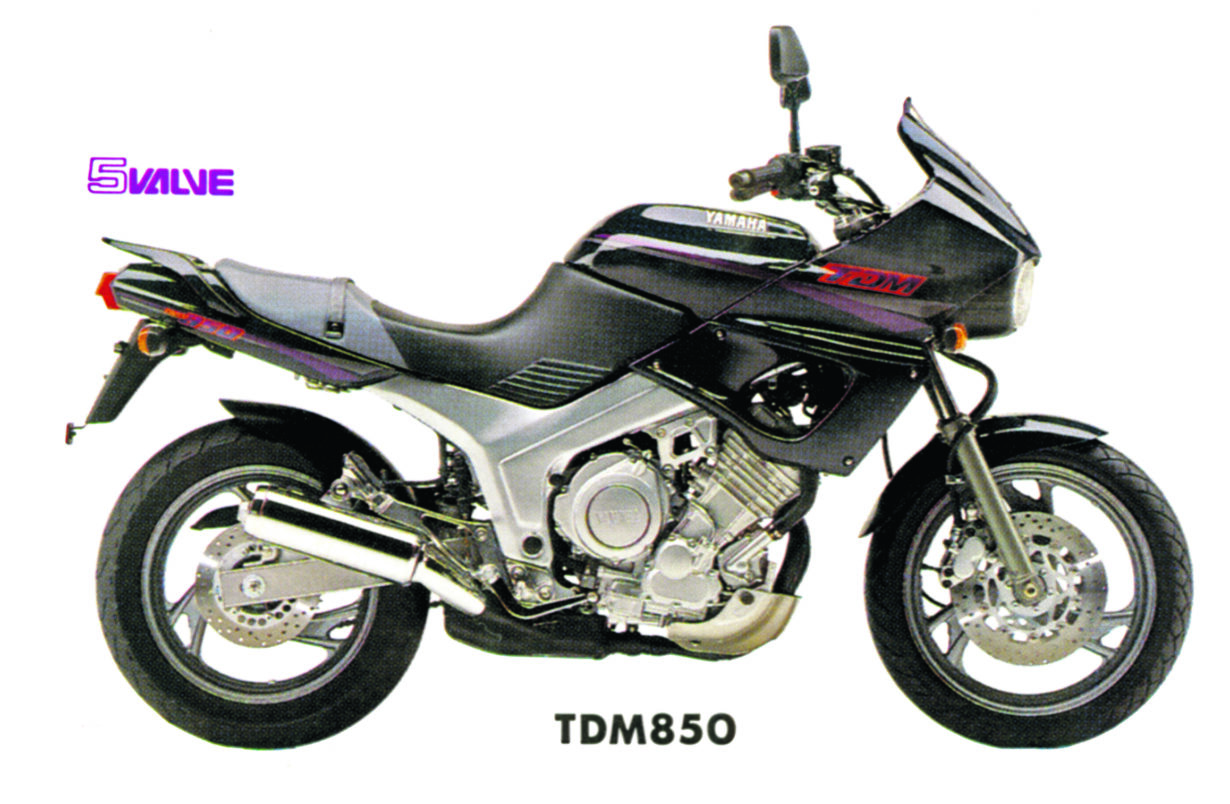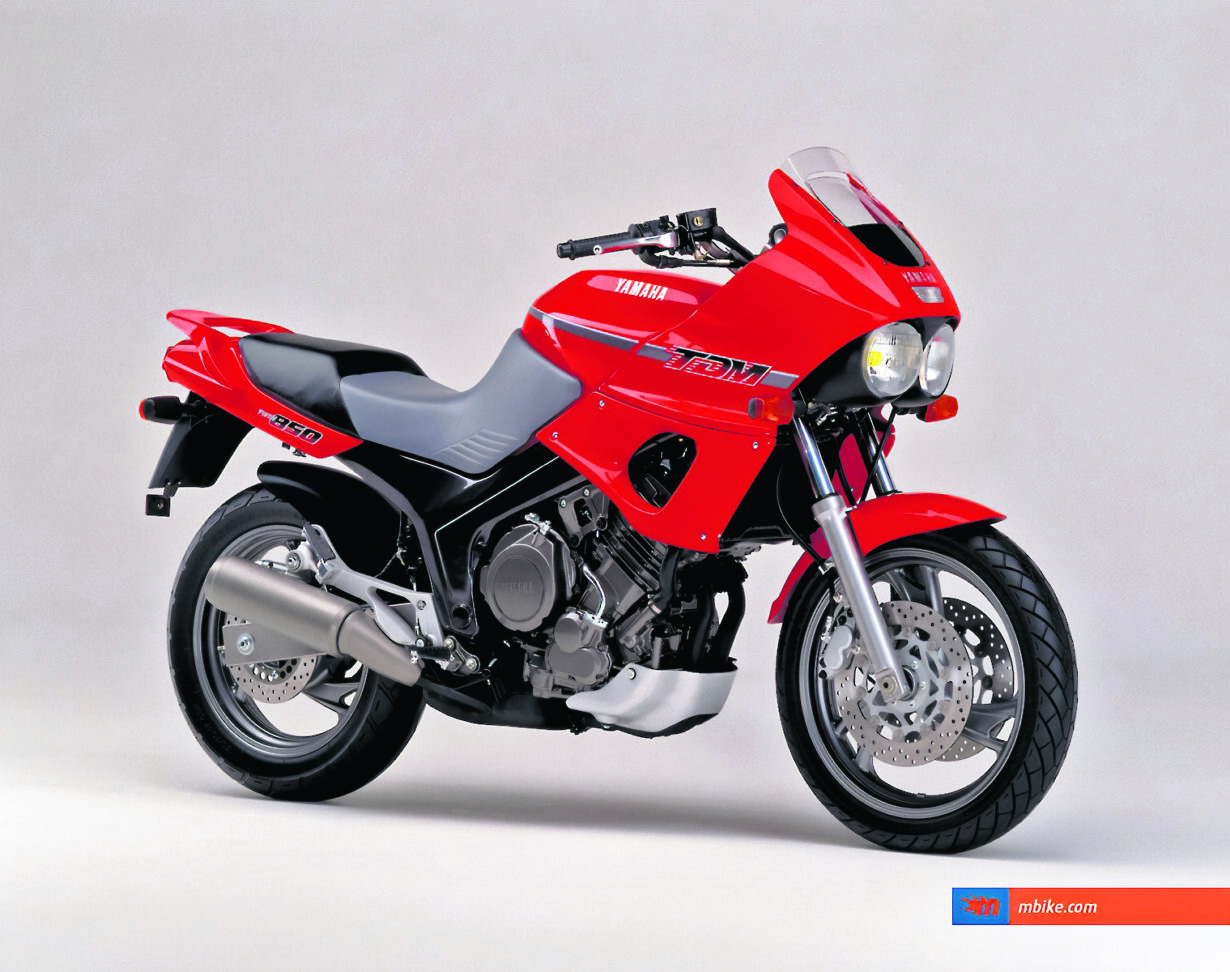It’s a big bore parallel twin… before they became popular again!
We’ll get the acid drop rebuke out of the way first – TDM is very much not a contraction of tedium. This sarcastic moniker has plagued the big twin from the off by people who simply didn’t ‘get’ the bike. The TDM has often been described by long-term owners as… ”the only bike you’ll ever need” …and if that’s the case it’s a very strong compliment.
Yamaha has a long-term relationship with big bore four-stroke twins that goes all the way back to the later 1960s. From the hugely successful XS-1 650 on to the flawed TX500/750s and through to the groundbreaking MT-07 series of today it’s been a constant theme. Yamaha has long held the opinion that large-capacity bikes don’t automatically have to run four cylinders… and with some justification. Properly designed big twins are lighter and generally less bulky than fours and often have a more accessible torque curve. The very fact that the market has recently swung heavily in favour of big twins completely and utterly vindicates Yamaha’s long-held beliefs. Oh, and know that the bike here is now referred to as the Multistrada 12 years before Ducati thought of it!
Enjoy everything MSL by reading the monthly magazine, Subscribe here.

THE BIKE
The TDMs owe their existence to the big trail bike known as the XTZ750, aka Super Ténéré. This was a big bore trailie that shook up the off-road world by the scruff of its neck; this is the machine that really galvanised the world of adventure bikes. While the Super Ténéré certainly made its mark, it wasn’t a huge seller so it was almost inevitable that the motor would end up in a road-going machine at some point. Yamaha upped the capacity by 100ccs and revised various key areas. The end result was another ground-breaking motorcycle that totally rewrote the rules.
What you got for your money was near superbike performance wrapped in Yamaha’s signature Deltabox frame of the period powered by a liquid-cooled twin-cylinder motor running five-valve cylinder heads. The styling was like nothing else of the time with a pair of insect-like headlights mounted in a half fairing which offered reasonable upper body protection. This gave a decent riding position and the only criticism ever levelled at the bike was a slightly hard seat. Wide bars allowed the rider to sit upright – a big change there compared to the contemporary sportsbikes – making for a well-thought-out ergonomic package. The suspension was deliberately set up on the soft side to facilitate ease of use and few that fully grasped the concept wanted to change it much. That said, suitably equipped with race-type suspension, a tweaked TDM makes for a stunning Q bike. Passengers had also been in the original design brief as the TDM was a very competent and comfortable ‘two-up’ machine.

Performance wasn’t exactly shabby and the 77bhp motor could dispatch quarter miles in around 12.5 seconds with the bike topping out at some 130mph. Not exactly a rocket ship, you say? Possibly not, but the way the bike made power was like little else.
Almost 60lb-ft of torque was delivered at the relatively low engine speed of just 6000rpm. People who had never experienced a bike with such a large, creamy, torque delivery were blown away.
Sales in both America and the UK were never much better than so-so, mainly because both buyers and the bike press were still irrationally focussed on performance for performance sake. It also took a while for mainland Europe to cotton on to the 850, do anything, go anywhere TDM, but once they collectively got their heads around the bike’s design ethos and its unquestionable functionality sales took off… they sold some 62,000 of them.
The bike was revised annually during its 11-year model run but the biggest change occurred in 1996. Originally the motor was configured around a 360-degree crank, but this was dropped in favour of a 270-degree unit as used on the out-and-out sports TRX850 that had been targeted at Ducati sportsbike owners. This change gave the bike a V twin soundtrack and drive whilst reducing vibration at the same time. It’s certainly no coincidence that the firm’s later MT-07 bikes had the same cross-plane crank design… or that many competitors’ parallel twins are similarly configured now. Yamaha has always been a trendsetter so it seems!
Yamaha billed the bike as an Adventure-Sports machine, which is a pretty accurate description – dual sports is the other title sometimes used. Both titles depict the bike rather well. Fast enough to impress and get the job don,e but not so silly-stupid as to put your licence or life at risk. Dual purpose also works well… easily competent as a long-distance toure, but also equally happy to play the role of commuter. Yamaha’s TDM850 – one of the modern classic scene’s most underrated, undervalued motorcycles.
LINEAGE AND LEGACY
2002 saw the release of the TDM900 which ran until 2011. The 900 had an upgraded motor and lightened running gear, and reflected many of Yamaha’s TDM850 customer feedback comments.
With a six-speed transmission and fuel injection it brought the bike bang up-to-date and in line with Yamaha’s corporate styling. Sales remained strong but for fans of the old 850 the looks were too bland and anonymous – the visual ‘edginess’ had been dialled out. More than a decade on everyone is making big bore twins with 270-degree cranks. Some might argue where Yamaha lead others follow… eventually!

WHY YOU MIGHT WANT ONE NOW
The TDM is simply one of the most competent, all-things-to-all-riders, motorcycles of the last 30 years. Yes, the modern takes on the same theme are lighter, sharper, faster even, but they’re not classics and don’t benefit from discount insurance schemes. The bike is, for many, one of the best blends of older machine with real world usability.
It’s planted, fast enough for most riders, looks like nothing else (especially the earliest versions), and has character by the bucket-load.
With the class-leading Deltabox chassis, proven five valve heads, twin-cylinder stomp and a strong rep, there’s genuinely not a lot to dislike.
TYPICAL PRICES
Oh this bit is good. A perfectly viable TDM850 with Cat C insurance status could be yours from just £800! Written off as the costs to repaint a minor off were ‘too much’, the one we spotted had just been serviced and had the R1 calipers upgrade fitted. £1400 would get you something slightly less jaded; a really smart one in Thundercat yellow/silver is only £2000; and £3000 should buy you a very tidy, low-mileage example that would want for very little. Our choice? Probably the first year model with its slightly edgy looks and preferably in red.
Faults and Foibles
1. ELECTRICS
If the thermostat or fan switch play up the radiator’s cooling fan may stay on.
2. CARBURATION
Needles and main jets are known to wear, giving rough running and flat spots.
3. BACKFIRING
Small corrosion holes in the exhaust can cause backfiring.
4. CLUTCH
Some will have had the clutch plates replaced under the dealer recall. If not, worth investigating.
5. SUSPENSION
Possibly a bit tired now but lots of options available to upgrade.
6. OIL LEAK
Check for a weeping oil seal behind the front sprocket – easy to fix.
Summary
In the modern world of two wheels, parallel twin cylinder motorcycles are the new must-have. Yet, decades before manufacturers rediscovered the concept, Yamaha was already flying the flag. From 1991 to 2001 the TDM was Europe’s second best-selling model which say a lot about the bike. Hugely underrated and criminally overlooked, the bike has to be one of the best cost-effective classics out there.
WORDS: Steve Cooper PHOTOS: Mortons Archive






